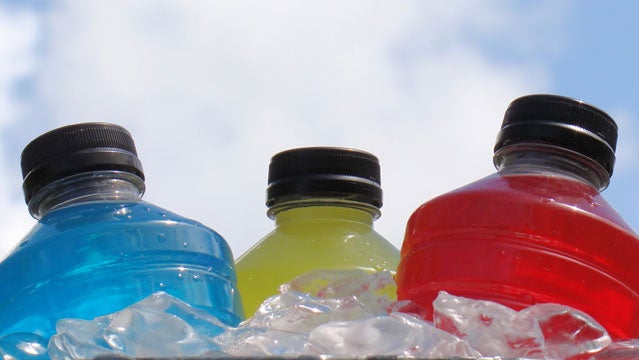╠²
Chuck Wagner via Shutterstock
WeŌĆÖve all heard the stories of how backcountry endurance wonks concocted the first molar-crushing energy bars in their kitchen or garage, and went on to hit the big time, spawning a sport-snack empire and changing the way we eat on the go. Buh-bye, trail mix.╠²
Mass-market sports drinks arenŌĆÖt so different: They started niche, designed for athletes who needed to replace vital electrolytes before, during, and after training. But as the industry grew, the message became more generic: Anybody who so much as moves his/her body or breaks a sweat must re-hydrate with a special drink in neon hues that donŌĆÖt exist in the natural world. Now sports drinks are so ubiquitous, they take up half an aisle at the grocery store.╠²
But just because the labels say ŌĆ£sport,ŌĆØ doesnŌĆÖt mean these drinks are good for youŌĆöa fact that even health-conscious athletes and parents tend to overlook. (Guilty.) ŌĆ£Most bottled sports drinks are full of chemicals and fake coloring like yellow #5 and caramel #1 to make them appealing to consumers,ŌĆØ says , a registered holistic nutritionist in the badass mountain burg of Nelson. B.C., whose clients include skiers, mountain bikers, climbers, and kids. ŌĆ£Some even contain vegetable oilŌĆöand you can be sure itŌĆÖs the poorest quality.ŌĆØ
HmmmŌĆ”you donŌĆÖt want your little ripper depleted and dehydrated after tearing it up on the local mountain bike course, but you donŌĆÖt want him sucking down 16 ounces of turquoise sugar water, either. So what to do? Make your own!
ŌĆ£ItŌĆÖs cheaper and much more healthful,ŌĆØ says Kierstead, whose recipe is so easy it only has 4 ingredients: organic lemon juice to replenish vitamin C, as well as key minerals like calcium, magnesium, and iron; raw honey to act as carbohydrate and supply muscles with quick energy; sea salt to replace lost minerals, and filtered water to replace fluids youŌĆÖve sweated out.
Simple, with a few teensy caveats. ŌĆ£You want to use raw or unpasteurized honey,ŌĆØ explains Kierstead. ŌĆ£The live enzymes help with digestion and keep your intestinal track healthy.ŌĆØ Sea salt is better than table salt because itŌĆÖs unprocessed. Pay attention to where your salt is harvested, too: KiersteadŌĆÖs partial to Himalayan, Icelandic, or Atlantic sea salt. ŌĆ£After Fukushima, I worry about the poor Pacific Ocean,ŌĆØ she says. Make a batch and keep a pitcher in the ‘fridge all summer.
Homemade ŌĆ£ElectroladeŌĆØ
1 quart filtered water
2 tablespoons unpasteurized or raw honey *
big pinch of unrefined sea salt
┬╝ cup juice from fresh, organic lemons
Mix 4 ingredients with a wooden spoon and chill; Kierstead prefers glass pitchers whenever possible, to avoid chemicals leaching from plastic jugs. For an icier yum the little rascals will love, pour into popsicle molds and freeze.╠²
╠²* The American Academy of Pediatrics advises against feeding honey to babies younger than 12 months╠² to prevent the risk of infant botulism.╠²